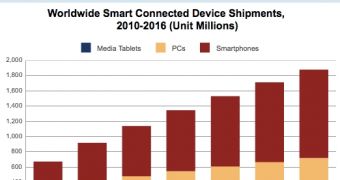For anyone wondering why web providers and consortiums were all over themselves to expand the library of IP addresses and the worldwide web bandwidth, we have an answer.
There used to be a time when only computers were connected to the Internet, and little else, so there wasn't much pressure.
The past decade drastically changed this though, and now almost everything electronic, that consumers commonly know of, has web access.
IDC looked into the matter and discovered that about 916 million smart connected devices were sold in 2011 alone.
That means over $489 billion worth of PCs, media tablets and smartphones (367.11 billion Euro).
"Whether it's consumers looking for a phone that can tap into several robust 'app' ecosystems, businesses looking at deploying tablet devices into their environments, or educational institutions working to update their school's computer labs, smart, connected, compute-capable devices are playing an increasingly important role in nearly every individual's life," said Bob O'Donnell, vice president, Clients and Displays at IDC.
By 2012, IDC predicts that PCs will slip from their 35.9% share to 25.1%, while tablets and phones, put together, will rise from 29.4% to a leading 31.1%. Products running iOS will also climb from 14.6% to 17.3%.
"Android's growth is tied directly to the propagation of lower-priced devices," said Tom Mainelli, research director, Mobile Connected Devices.
"So, while we expect dozens of hardware vendors to own some share in the Android market, many will find profitability difficult to sustain. Similarly, we expect a large percentage of application developers to continue to focus their efforts on iOS, despite the platform's smaller overall market share, because iOS end users have proven more willing to pay for high-quality apps."

 14 DAY TRIAL //
14 DAY TRIAL //